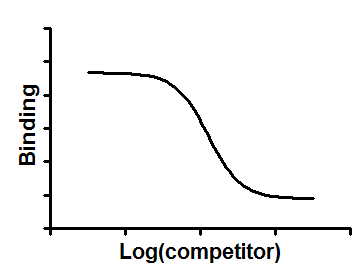Introduction
This model for competitive binding is useful when a large fraction of the added radioligand binds to the receptors, so the concentration you added is greater than the free concentration.
These equation allows for a substantial fraction of the added ligand to bind. This only works with radioactive ligands, so the assessment of added ligand and bound ligand are in the same counts-per-minute units. This method doesn't work with fluorescent ligands.
Step by step
Create an XY data table. Enter the logarithm of the molar concentration of the unlabeled compound into X, and binding into Y. The Y values must be in cpm.
If you have several experimental conditions, place the first into column A, the second into column B, etc. Use subcolumns to enter replicates.
From the data table, click Analyze, choose nonlinear regression, choose the panel of Competition Binding equations, and choose One site -- Heterologous with depletion.
You must constrain four parameters to constant values based on your experimental design:
•Hot is the amount of labeled ligand in cpm. A single concentration of radioligand is used for the entire experiment.
•KdNM is the equilibrium dissociation constant of the labeled ligand in nM.
•SpAct is the specific radioactivity in cpm/fmol.
•Vol is the reaction volume in ml.
Model
KdCPM=KdnM*SpAct*vol*1000
; nmol/L *(cpm/fmol * ml * .001L/ml * 1000000fmol/nmol) = cpm
R=NS+1
S=[1+10^(X-LogKi)]*KdCPM+Hot
a=-1*R
b=R*S+NS*Hot + Bmax
c= -1*Hot*(S*NS + Bmax)
Y= (-1*b + sqrt(b*b-4*a*c))/(2*a)

Interpret the parameters
logKI is the log of the molar equilibrium dissociation constant of unlabeled ligand.
Ki is the equilibrium dissociation constant in Molar.
Bmax is the maximum binding of ligand to receptors in cpm. This represents binding to all the receptors so is higher than the top plateau of the curve.
NS is the fraction of the radioligand that binds to nonspecific sites.
Notes
This analysis accounts for the fact that a large fraction of the added radioligand binds to the receptors. If you are able to assume that only a small fraction of radioligand binds, which means that the concentration you added is virtually identical to the free concentration, use an alternative analysis.
Reference
This equation came from S. Swillens (Molecular Pharmacology, 47: 1197-1203, 1995)